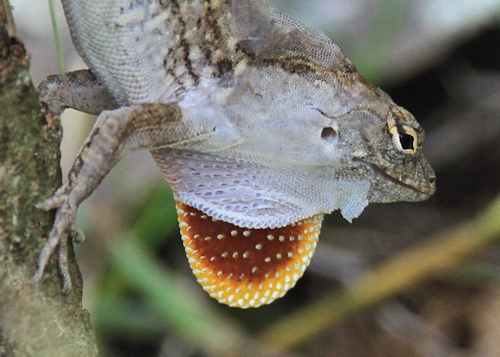I’ve been looking through a lot of anole museum specimens lately, and I’ve noticed that many of them have pretty pronounced endolymphatic glands, which made me curious about their prevalence and function in anoles generally.
Endolymphatic glands serve as calcium reserves, and are present in many animals, including a number of reptile and amphibian clades. According to Etheridge (1959), these glands are present in anoles and a few of their close relatives (e.g. Polychrus), but not in any other Iguanians. But it looks like most of the research on their function (in reptiles) has focused on geckos. In geckos, the size of the glands has been shown to fluctuate in response to both stress and reproductive activity, supporting the idea that the stored calcium is used in egg production, both for the yolk and the shell (Brown et al. 1996, Lamb et al. 2017). However, in anoles and geckos, these glands are present in both males and females, so their function isn’t limited to providing calcium for eggs (Etheridge 1959, Bauer 1989, Lamb et al. 2017).
But I haven’t found much information on these glands in anoles. I personally haven’t noticed them in the wild, but so far I’ve found very pronounced glands in 13/66 museum specimens, and some of them are really striking (see photos)! So I’m curious to hear, how often do you other anole-ologists see these enlarged glands? Is there any other literature about their prevalence, seasonality, or function in anoles that I’ve overlooked? Seems like we might be lagging behind the gecko crowd on this topic!
Citations:
Bauer A (1989) Extracranial Endolymphatic Sacs in Eurydactylodes ( Reptilia : Gekkonidae), with Comments on Endolymphatic Function in Lizards. J Herpetol 23:172–175.
Brown SG, Jensen K, DeVerse HA (1996) The Relationship Between Calcium Gland Size, Fecunduty and Social Behavior in the Unisexual Gecks Lepidactyluse Lugubris and Hemidactylus Garnotii. Int J Comp Psychol. doi: 10.5811/westjem.2011.5.6700
Etheridge R (1959) The relationships of the anoles (Reptilia: Sauria: Iguanidae) an interpretation based on skeletal morphology.
Lamb AD, Watkins-colwell GJ, Moore JA, et al (2017) Endolymphatic Sac Use and Reproductive Activity in the Lesser Antilles Endemic Gecko Gonatodes antillensis (Gekkota: Sphaerodactylidae). Bull Peabody Museum Nat Hist 58:17–29.



 Two male festive anoles (Anolis sagrei) fighting in Texas. From
Two male festive anoles (Anolis sagrei) fighting in Texas. From 











